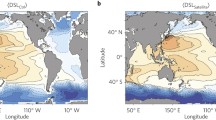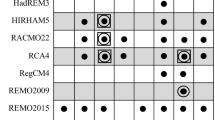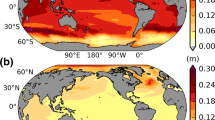Abstract
The effect of large-scale atmospheric pressure changes on regional mean sea level projections in the German Bight in the twenty-first century are considered. A developed statistical model is applied to climate model data of sea level pressure for the twenty-first century to assess the potential contribution of large-scale atmospheric changes to future sea level changes in the German Bight. Using 78 experiments, an ensemble mean of 1.4-cm rise in regional mean sea level is estimated until the end of the twenty-first century. Changes are somewhat higher for realisations of the special report on emission scenarios (SRES) A1B and A2, but generally do not exceed a few centimeters. This is considerably smaller than the changes expected from steric and self-gravitational effects. Large-scale changes in sea level pressure are thus not expected to provide a substantial contribution to twenty-first century sea level changes in the German Bight.




Similar content being viewed by others
Notes
20- and 37-year trends were chosen because 20 years is a period often considered in sea level analysis in literature and 37 years is twice the cycle of the nodal tide, which might influence decadal trends in the North Sea.
References
Albrecht F, Wahl T, Jensen J, Weisse R (2011) Determining sea level change in the German Bight. Ocean Dyn 61:2037–2050. doi:10.1007/s10236-011-0462-z
Albrecht F, Weisse R (2012) Pressure effects on past regional sea level trends and variability in the German Bight. Ocean Dyn 62:1169–1186. doi:10.1007/s10236-012-0557-1
Deuflhard P., Hohmann A. (1993) Numerische Mathematik I, Eine algorithmisch orientierte Einführung. 2. Auflage, Walter de Gruyter, Berlin
Gönnert G, Jensen J, von Storch H, Thumm S, Wahl T, Weisse R (2009) Der Meeresspiegelanstieg Ursachen, Tendenzen und Risikobewertung. Die Küste 76:225–256
Holgate S., Jevrejeva S., Woodworth P., Brewer S. (2007) A semi-empirical approach tp projecting future sea-level rise. Science 317. doi:10.1126/science.1140942
Katsman CA, Hazeleger W, Drijfhout SS, van Oldenborgh GJ, Burgers JHB (2008) Climate scenarios of sea level rise for the northeast Atlantic Ocean: a study including the effects of ocean dynamicy and gravity changes induced by ice melt. Clim Chang 91:351–374. doi:10.1007/s10584-008-9442-9
Katsman CA, Sterl A, Beersma JJ, van den Brink HW, Church JA, Hazeleger W, Kopp RE, Kroon D, Kwadijk J, Lammersen R, Lowe J, Oppenheimer M, Plag H-P, Ridley J, von Storch H, Vaughan DG, Vellinga P, Vermeersen LLA, van de Wal RSW, Weisse R (2011) Exploring high-end scenarios for local sea level rise to develop flood protection strategies for a low-lying delta—the Netherlands as an example. Clim Chang 109:617–645. doi:10.1007/s10584-011-0037-5
Lowe JA, Howard TP, Pardaens A, Tinker J, Holt J, Wakelin S, Milne G, Leake J, Wolf J, Horsburgh K, Reeder T, Jenkins G, Ridley J, Dye S, Bradley S (2009) UK Climate Projections science report: marine and coastal projections. Met Office Hadley Centre, Exeter, UK
Meehl GA, Stocker TF, Collins WD, Friedlingstein P, Gaye AT, Gregory JM, Kitoh A, Knutti R, Murphy JR, Noda A, Raper SCB, Watterson IG, Weaver AJ, Zhao ZC, Averyt KB (2007) Global climate projections. In: Solomon S, Qin D, Manning M, Chen Z, Marquis M, Tignor M, Miller HL (eds) Climate change 2007: the physical science basis. Contribution of working group I to the fourth assessment report of the intergovernmental panel on climate change. Cambridge University Press, Cambridge
Meehl GA, Covey C, Delworth T, Latif M, McAvaney B, Mitchell JFB, Stouffer RJ, Taylor KE (2007a) The WCRP CMIP3 multi-model dataset: a new era in climate change research. Bull Am Meteorol Soc 88:1383–1394. doi:10.1175/BAMS-88-9-1383
Rahmstorf S (2007) A semi-empirical approach to projecting future sea-level rise. Science 315:368–370. doi:10.1126/science.1135456
Reichler T, Kim J (2008) How well do coupled models simulate today’s climate?Bull Am Meteorol Soc 89:303–311. doi:10.1175/BAMS-89-3-303
Schmidt T, Johanson S, Thejll P (2007) A semi-empirical approach to projecting future sea-level rise. Science 317. doi:10.1126/science.1143286
Slangen ABA, Katsman CA, van de Wal RSW, Vermeersen LLA, Riva REM (2012) Towards regional projections of twenty-first century sea-level change based on IPCC SRES scenarios. Clim Dyn 38:1191–1209. doi:10.1007/s00382-011-1057-6
Tsimplis MN, Woolf DK, Osborn TJ, Wakelin S, Wolf J, Flather R, Shaw AGP, Woodworth P, Challenor P, Blackman D, Pert F, Yan Z, Jevrejeva S (2005) Towards a vulnerability assessment of the UK and Northern European coasts: the role of regional climate variability. Phil Trans R Soc A 363:1329–1358. doi:10.1098/rsta.2005.1571
Vermeer M, Rahmstorf S (2009) Global sea level linked to global temperature. Proc Natl Acad Sci USA 106:21527–21532. doi:10.1073/pnas.0907765106
von Storch H, Zwiers F (1998) Statistical analysis in climate research. Cambridge University press, Cambridge
von Storch H, Zorita E, González-Rouco JF (2008) Relationship between global mean sea-level and global mean temperature and heat flux in a climate simulation of the past millennium. Ocean Dyn 58:227–236. doi:10.1007/s10236-008-0142-9
von Storch H, Zwiers F (2013) Testing ensembles of climate change scenarios for statistical significance. Clim Chang 117:1–9. doi:10.1007/s10584-012-0551-0
Acknowledgments
We acknowledge the modelling groups, the Program for Climate Model Diagnosis and Intercomparison (PCMDI) and the WCRP’s Working Group on Coupled Modelling (WGCM) for their roles in making available the WCRP CMIP3 multi-model dataset. Support of this dataset is provided by the Office of Science, US. Department of Energy. This work is a contribution to the ‘Helmholtz Climate Initiative REKLIM’ (Regional Climate Change), a joint research project of the Helmholtz Association of German research centres (HGF).
Author information
Authors and Affiliations
Corresponding author
Additional information
Responsible Editor: Birgit Andrea Klein
Appendix: additional plots
Appendix: additional plots
Results of the statistical model (1) for future RMSL of the German Bight introduced by the large-scale SLP-field over the North Atlantic in the twenty-first century. The results are given for each climate model and the scenarios are given in different colours. The name of the considered climate model is indicated in the headline
Results of the statistical model (1) for future RMSL of the German Bight introduced by the large-scale SLP-field over the North Atlantic in the twenty-first century. The results are displayed for each climate model and the scenarios are given in different colours. The name of the considered climate model is indicated in the headline
Results of the statistical model (1) for future RMSL of the German Bight introduced by the large-scale SLP-field over the North Atlantic in the twenty-first century. The results are displayed for each climate model and the scenarios are given in different colours. The name of the considered climate model is indicated in the headline
Results of the statistical model (1) for future RMSL of the German Bight introduced by the large-scale SLP-field over the North Atlantic in the twenty-first century. The results are displayed for each climate model and the scenarios are given in different colours. The name of the considered climate model is indicated in the headline
Rights and permissions
About this article
Cite this article
Albrecht, F., Weisse, R. Pressure effects on regional mean sea level trends in the German Bight in the twenty-first century. Ocean Dynamics 64, 633–642 (2014). https://doi.org/10.1007/s10236-014-0708-7
Received:
Accepted:
Published:
Issue Date:
DOI: https://doi.org/10.1007/s10236-014-0708-7









